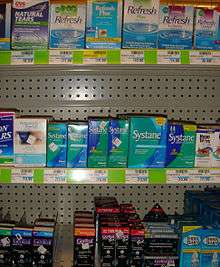Artificial tears

Artificial tears are lubricant eye drops used to treat the dryness and irritation associated with deficient tear production in keratoconjunctivitis sicca (dry eyes).[1] They are also used to moisten contact lenses and in eye examinations.
Artificial tears are available over-the-counter. Artificial tears are supplemented with other treatments in moderate to severe forms of dry eyes.
Chemistry
Preparations contain carboxymethyl cellulose,[2] polyvinyl alcohol,[2] hydroxypropyl methylcellulose[2] (a.k.a. HPMC or hypromellose), hydroxypropyl cellulose[1] and hyaluronic acid (a.k.a. hyaluronan, HA)[3] They contain water, salts and polymers but lack the proteins found in natural tears. Patients who use them more frequently than once every three hours[1] should choose a brand without preservatives[1] or one with non-irritating preservatives.
Effects
Application of artificial tears every few hours[4] can provide temporary relief from the symptoms of dry eyes. Hydroxypropyl cellulose stabilizes and thickens the precorneal tear film and prolongs the tear film breakup time.[1]
Usage
Artificial tears usually are the first line of treatment for dry eyes.[5] While mild cases require application of lubricant drops four times a day, severe cases require more aggressive treatment, such as ten to twelve times a day.[1] Thicker artificial tears can be used in severe cases, although these may temporarily blur vision.[1]
Precautions
Drops for red eyes can make the eyes drier.[5] If wearing contact lenses, rewetting or lubricating drops specifically for contact lenses should be used.[5] Other types of drops may contain ingredients that damage contact lenses.[5]
Adverse effects, interactions and contraindications
Possible adverse effects of carboxymethyl cellulose and similar lubricants include eye pain, irritation, continued redness, and vision changes.[1] Use should be discontinued if any of them occur.[1] Side effects of hydroxypropyl cellulose include hyperaemia, photophobia, stickiness of eyelashes, discomfort, and irritation.[1] However, the overall side-effect profile of artificial tears is very low.[2]
Artificial tears have no reported interactions.[1] A documented contraindication of artificial tears is hypersensitivity.[1]
Veterinary uses
Artificial tears are a part of the topical therapy for keratoconjunctivitis sicca for animals such as dogs, cats and horses.[6]
Research
A 2016 Cochrane Review seeking to compare the effectiveness of various over the counter artificial tears in treating dry eye. While the review stated that is unclear which artificial tear formulation works best, two trials found that 0.2% polyacrylic acid-based tears were more effective in treating dry eye symptoms over 1.4% polyvinyl alcohol-based tears.[7]
See also
References
- 1 2 3 4 5 6 7 8 9 10 11 12 "Keratoconjunctivitis, Sicca". eMedicine. WebMD, Inc. 2006-04-21. Archived from the original on 16 October 2006. Retrieved 2006-11-12.
- 1 2 3 4 Moshirfar M, Pierson K, Hanamaikai K, Santiago-Caban L, Muthappan V, Passi SF (July 2014). "Artificial tears potpourri: a literature review". Clin Ophthalmol. 31 (8): 1419–33. doi:10.2147/OPTH.S65263. PMC 4124072
 . PMID 25114502.
. PMID 25114502. - ↑ Troiano, P; Monaco G (27 December 2008). "Effect of hypotonic 0.4% hyaluronic acid drops in dry eye patients: a cross-over study.". Cornea. 10 (10): 1126–30. doi:10.1097/ICO.0b013e318180e55c. PMID 19034126.
- ↑ "Keratoconjunctivitis Sicca". The Merck Manual, Home Health Handbook. Merck & Co., Inc. 2003-02-01. Retrieved 2006-11-12.
- 1 2 3 4 Meadows, Michelle (May–June 2005). "Dealing with Dry Eye". FDA Consumer. U.S. Food and Drug Administration. Archived from the original on January 20, 2009. Retrieved 14 May 2016.
- ↑ "Keratoconjunctivitis, Sicca". The Merck Veterinary Manual. Merck & Co., Inc. Retrieved 2006-11-18.
- ↑ Pucker AD; Ng SM; Nichols JJ (2016). "Over the counter (OTC) artificial tear drops for dry eye syndrome". Cochrane Database Syst Rev. 2: CD009729. doi:10.1002/14651858.CD009729.pub2. PMID 26905373.